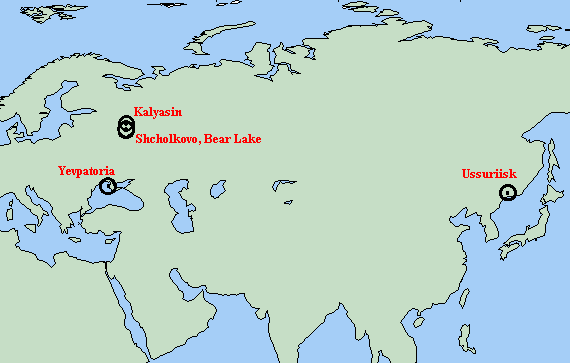
Radio systems

| Uplinks (MHz) | 770 | 960 | - |
|---|---|---|---|
| Downlinks (MHz) | 926 | 928 | 930 |
| Uplinks (GHz)-Polarization | 5.008-R | - | - |
|---|---|---|---|
| Downlinks (GHz)-Polarization | 5.84-L | 5.86-L | 5.884-L |
| Station name | Location | Antenna | Mode | Frequency | Remarks |
|---|---|---|---|---|---|
| Ussuriisk | 44o.0330N
131o.7550 E |
A70
A32 A25 |
T/R
R T |
L/C
L/C L/C |
-
- Tx Pwr: L=80 kW, C=8kW |
| Shcholkovo | 55o.9330N
37o.9690E |
A25 | T/R | L | Two antennas. Tx Pwr=40 kW |
| Bear Lake | 55o.8657888 N
37o.9546083 E |
TNA-1500
(64 m diam) |
R | L/C | Noise temperature 35- 85 K,
depending on elevation. |
| Kalyasin | On the Volga,
180 km from Moscow, 57o.194 N 37o.945 E |
TNA-1500
(64 m diam) |
R | L/C | Noise temperature 35- 85 K,
depending on elevation. |
| Yevpatoria | 45o.2166 N
33o.3666 E |
A70
A32 ADU-1000 |
T/R
T R |
L/C
L/C ? |
-
Tx Pwr: L=80 kW, C=8kW Eight 16 m diam dishes. |
These two sites are equipped with TNA-1500 radio telescopes with 64 meter diameter. These can be used for the reception of space vehicles on 926 MHz, 928 MHz, 5.84 GHz and 5.86 GHz. The noise temperature at all these frequencies varies between 35 and 85 K, depending on elevation.
The "Western Center" (#160) has two ADU-1000 antennas consisting of eight (8) 16 meter dishes coupled together on a truss. The center also has an A70 (70 meter diameter) dish used for receiving telemetry from the Russian Interball and Granat satellites and for commanding these satellites. In addition there is an A32 command transmision antenna with 32 meter diameter. It transmits 8 kW of power on 5 GHz and 80 kW on 770 MHz. There are also two 25-meter dishes.
![]() [Space
Radio Notes]
[Space
Radio Notes]
![]()
Copyright © 1996 Sven Grahn